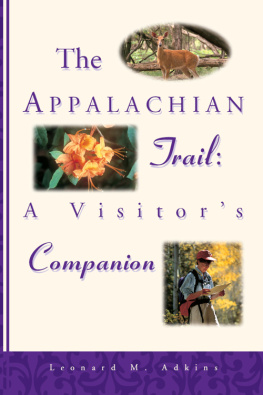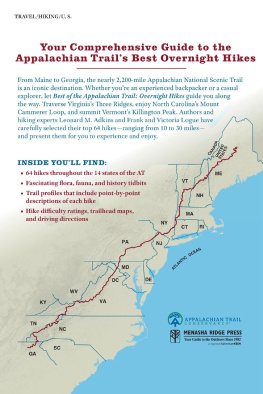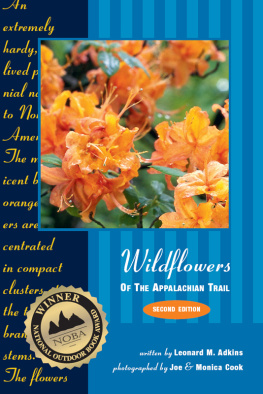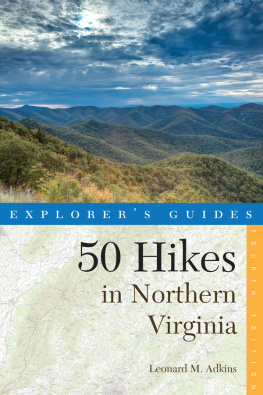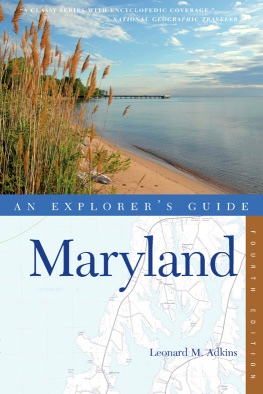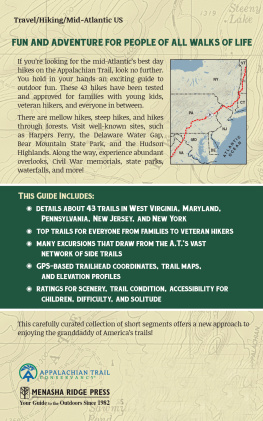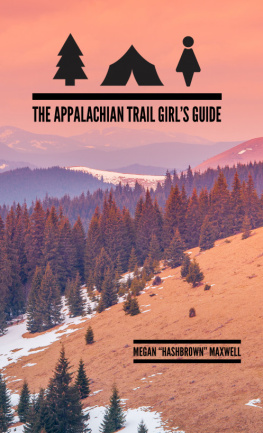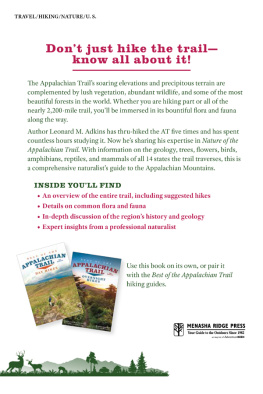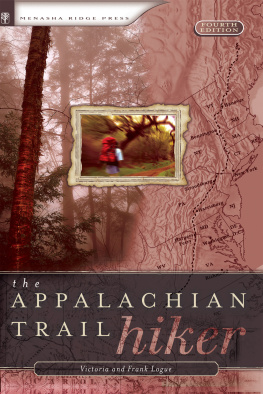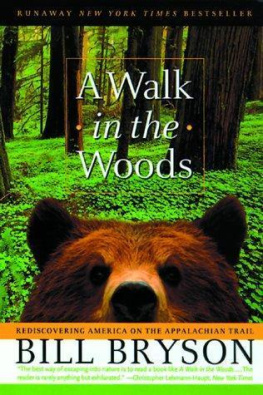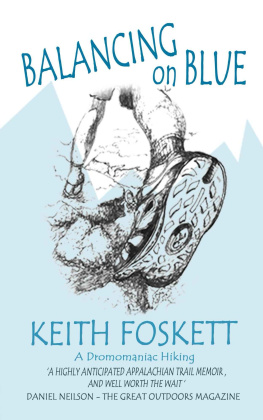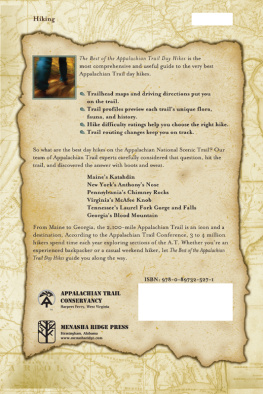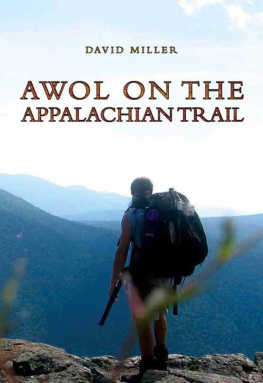ACKNOWLEDGMENTS
So many people provided assistance and encouragement throughout the entire process of preparing this book for publication that it would be impossible to acknowledge every one of them. However, special thanks must be expressed to Brian King, public affairs director of the Appalachian Trail Conference, for scrutinizing the chapters on the history and route of the Appalachian Trail; Ann Messick for her amazing knowledge of flowers (and their scientific names); Dan Smith, professor at Iona College for looking over several chapters in their early stages of development; V. Collins Chew, author of Underfoot: A Geologic Guide to the Appalachian Trail , as the geology chapter would never have been finished without his help, although the final draft may not coincide completely with his opinions; Karen Michaud, Leader, Interpretation and Education Unit of Shenandoah National Park, for verifying information about the park; Janet Williams, Robert Williams, and Michael Greenwald for their generous permission to reprint their bird checklist; Greta Miller, executive director of the Shenandoah Natural History Association, for permission to use the associations bird checklist; Dr. Stephen Lewis and Caroline Charonko for the new life Ive been granted.
The biggest thank-yous go to Benton MacKaye for having dreamt of the Appalachian Trail in the first place and to every trail volunteer who has ever worked to make and keep that dream a reality.
The final thanks must go to Laurie, for without her, none of my travels, writings, or happiness would be possible.
ABOUT THE AUTHOR
Leonard M. Adkins has been having a love affair with the Appalachian Trail for nearly two decades. He has walked its full length four times, and lacks less than seven hundred miles of completing it for a fifth time.
In addition to the AT, he has traversedamong other long distance trailsthe Continental Divide Trail from Canada to Mexico, Canadas Great Divide Trail, and the Pyrenees High Route along the border of France and Spain. In all, he has hiked more than 16,000 miles exploring the backcountry areas of the United States, Canada, Europe, and the Caribbean.
Jobs as an interpreter for the Virginia State Parks system and as an assistant director for George Mason Universitys Outdoor Education Center helped increase his appreciation for and knowledge of the natural world.
When not wearing out boot tread, Leonard spends his time lecturing, writing articles and books, and publishing photographs based upon his adventures.
Along with his thru-hiking wife, Laurie, and thru-hiking dog, MacAfee of Knob, he lives in Catawba, Virginiajust a few hundred yards from the AT.
A CONCISE HISTORY OF THE APPALACHIAN TRAIL
The ultimate purpose of the Appalachian Trail ? To walk. To see. And to see what you see.
~ Benton MacKaye
Although other people had put forth similar ideas, Benton MacKayes article An Appalachian Trail: A Project in Regional Planning, which appeared in the October 1921 issue of the Journal of the American Institute of Architects, is generally regarded as having provided the impetus for the Appalachian Trail (AT). A regional planner, MacKaye saw in the postWorld War I era an America that was becoming rapidly urbanized, machine-driven, and far removed from the positive and reinvigorating aspects of the natural world. In addition to providing obvious recreational opportunities, the trail he envisioned would be a connecting line between a series of permanent, self-sustaining camps in which cooperation replaces antagonism, trust replaces suspicion, emulation replaces competition.
Encouraged and aided by relatives, friends, and like-minded acquaintances, MacKaye set about spreading the idea of an Appalachian Trail to anyone who would listen, including officials of the National Park and National Forest Services. Especially receptive to the trail concept were members and officers of already existing trail organizations such as the Green Mountain Club of Vermont, the New England Trail Conference, and the Appalachian Mountain Club. Not overlooking the publicity power of the press, MacKaye also solicited the support of newspaper reporters and columnists throughout the Northeast. The idea struck a chord for, in October 1923, just two years after publication of his article, the first few miles of trail to be built specifically as a part of the AT were opened to the public in the area of Harriman and Bear Mountain State Parks in New York by the then recently formed New YorkNew Jersey Trail Conference.
Acting upon a request by MacKaye and others, the Federal Societies on Planning and Parks met in Washington, D.C., in March 1925, for the purpose of furthering action on the AT. There, a constitution establishing the Appalachian Trail Conference (ATC) was adopted, and William A. Welch, of New Yorks Palisades Interstate Park Commission, was named its chairman. During the meeting, it was decided that the AT would run approximately 1,700 miles from Mount Washington in New Hampshire to Cohutta Mountain in northwestern Georgia. A northern extension was to stretch to Mount Katahdin in Maine while a southern addition would reach all of the way to Birmingham, Alabama. Among various branch routes that were also proposed, one was to follow the Long Trail in Vermont, another would extend into the Catskills, and another was to run along the Tennessee River into Kentucky.
With the establishment of the Potomac Appalachian Trail Club (PATC) in 1927, and the appointments of Arthur Perkins and Myron H. Avery as ATC chairman and assistant chairman in 1928, construction of the AT began to rapidly accelerate. Avery, a founding member of the PATC whose indefatigable energies have been likened to those of Bob Marshall, took it upon himself to recruit volunteers and to spread the word about the AT. Perhaps more importantly, he went out into the field scouting practical routes for the trail and building and blazing multiple miles of the pathway. With his help, and within four years of its formation, the PATC constructed more than 250 miles of trail and solicited enough volunteers to create trail clubs that would reach all of the way to Georgia.
With more than 1,200 miles of the AT completed, Avery became ATC chairman in 1931. Under his tutelage, construction of the trail throughout its entire north-south route continued to accelerate, and more than 1,900 miles of trail were completed by the end of 1934.
Sadly, during this time, it was becoming obvious that the two most avid proponents of the AT had different visions of what the trail should be. MacKaye continued to iterate that the pathway was more or less a means for regional planning, a way to establish workers communities along its route. His hope was that those communities would help to foster an America that would question the continued expansion of its cities and the increasing enslavement to mechanized work and commercialism. Avery, on the other hand, saw the trail as a footpath through the mountains for those who wished to enjoy the benefits of outdoor recreational opportunities.
Construction of the Skyline Drive through Shenandoah National Park drove the final wedge between the two men. Avery accepted the venture, seeing it as a means of acquiring further federal governmental support for the AT, thereby aiding his agenda of completing the trail as quickly as possible. In some ways he was correct for, at the very least, the portion of the AT that was displaced by the Skyline Drive project was relocated and reconstructed by the government-funded Civilian Conservation Corps (CCC). Having set a precedent, other divisions of the CCC ended up constructing significant portions of the trail throughout its entire route. It is a lasting tribute to these hardworking men that most of the trail sections they built in the 1930s are still in use today, requiring little maintenance or repair.
Next page
